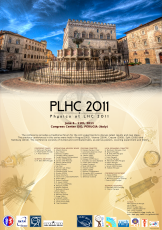Dominick John Olivito
(University of Pennsylvania)
10/06/2011, 16:30
Many extensions of the Standard Model predict the existence of additional, heavy gauge bosons. The ATLAS detector is used to search for high-mass states, such as charged and neutral heavy gauge bosons, (W',Z’) decaying to a charged lepton (electron or muon) and a neutrino or into two leptons, respectively in the 2011 data.
Carmen Diez Pardos
(CIEMAT Madrid)
10/06/2011, 16:50
We present the results of searches for excited leptons and new heavy gauge bosons in leptonic final states in the pp collisions at 7 TeV delivered by LHC and collected with the CMS detector in 2010. No excess of events above the standard model predictions has been found.
Jessie Shelton
(Yale University)
10/06/2011, 17:10
The long-standing Tevatron anomaly in the top forward-backward asymmetry has been the focus of a recent wave of model building. I will discuss models which account for the asymmetry and the prospects for related measurements at the LHC in both the short- and long-term. Two strategies for measuring related asymmetries at the LHC will be detailed, with large beyond-the-standard-model...
Ka Vang Tsang
(Department of Physics - Brown University)
10/06/2011, 17:30
We present the results of a search for large extra spatial dimensions with the pp collisions at 7 TeV collected with CMS in 2010. No excess of events above the standard model predictions has been found. Limits are set on the effective Planck scale.
Diane Cinca
(LPC Clermont-F.)
10/06/2011, 17:50
Many models beyond the standard model predict that new particles decaying into final states with top quarks. The ATLAS search results for top quark pair resonances in the 2011 data are reported.
Anne-Fleur Barfuss
(Kansas State University)
10/06/2011, 18:10
We present the results of searches for pair-production of leptoquarks and bottom-like fourth generation quark b′ in pp collisions at 7 TeV collected with CMS in 2010. No excess of events above the standard model predictions has been found. Limits are set on the production cross section, some of which are the most stringent to date.
